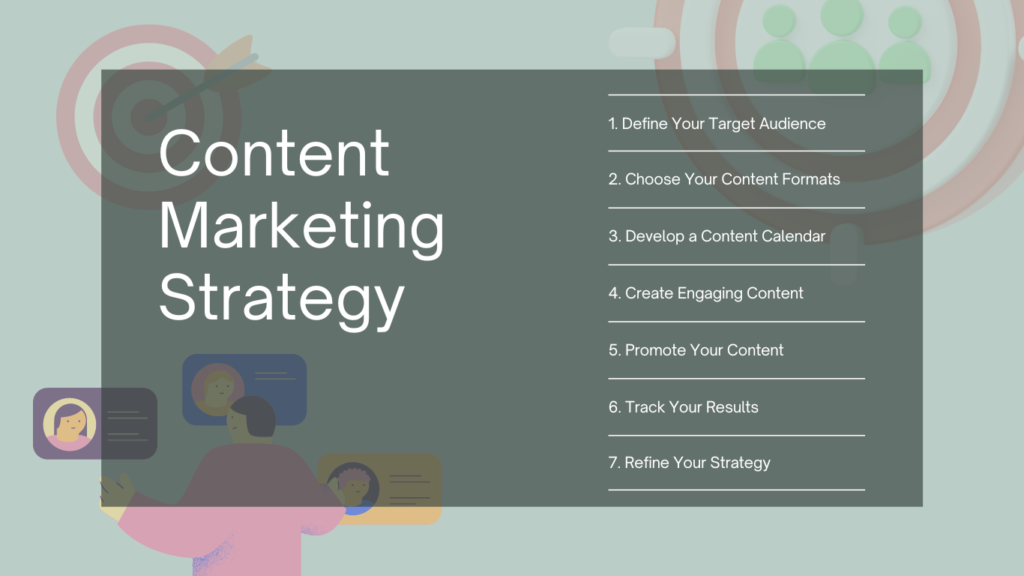Content marketing is a long-term strategy for building relationships with your target audience and driving traffic to your website. By creating and distributing valuable, relevant, and consistent content, you can attract and retain customers, build trust, and boost your brand.
However, creating a successful content marketing strategy is not easy. It requires careful planning and execution. In this blog post, we will walk you through the seven steps you need to take to create a content marketing strategy that will help you reach your target audience and grow your business.

1. Define Your Target Audience
The first step in creating a content marketing strategy is to define your target audience. Who are you trying to reach with your content? What are their needs and interests? Once you know who your target audience is, you can tailor your content to their specific needs.
There are a few different ways to define your target audience. You can use demographic data, psychographic data, or behavioral data. Demographic data includes information like age, gender, location, and income. Psychographic data includes information like interests, values, and lifestyle. Behavioral data includes information like what websites they visit, what social media platforms they use, and what products they buy.
Once you have gathered some information about your target audience, you can start to create personas. Personas are fictional representations of your ideal customers. They help you to understand your target audience’s needs, wants, and pain points.
2. Choose Your Content Formats
Once you know who your target audience is, you need to choose the right content formats for your content marketing strategy. There are a variety of content formats to choose from, including blog posts, articles, infographics, videos, podcasts, and social media posts.
When choosing content formats, it is important to consider your target audience and their needs. For example, if your target audience is busy professionals, you may want to focus on short-form content like blog posts and infographics. If your target audience is more visual, you may want to focus on videos and infographics.
3. Develop a Content Calendar
Once you have chosen your content formats, you need to develop a content calendar. A content calendar is a schedule that outlines your content creation and distribution schedule. This will help you to stay organized and on track with your content marketing efforts.
When creating a content calendar, it is important to consider the following factors:
- Your target audience’s needs and interests
- The different content formats you will be using
- Your budget
- Your available time
4. Create Engaging Content
Once you have developed a content calendar, you need to start creating engaging content. Your content should be informative, relevant, and interesting to your target audience.
There are a few different things you can do to create engaging content:
- Use strong headlines
- Write in a clear and concise style
- Use images and videos
- Tell stories
- Ask questions
- Use humor
5. Promote Your Content
Once you have created engaging content, you need to promote it so that people can find it. There are a variety of ways to promote your content, including social media, email marketing, and search engine optimization (SEO).
Social media is a great way to promote your content to a large audience. You can share your content on social media platforms like Facebook, Twitter, and LinkedIn. You can also use social media to engage with your audience and build relationships with them.
Email marketing is another effective way to promote your content. You can send your content to your email list or use email marketing automation software to send your content to people who have expressed interest in your topic.
SEO is the process of optimizing your website and content so that it ranks higher in search engine results pages (SERPs). When people search for keywords related to your business, your website and content will appear higher in the search results. This will help you attract more visitors to your website and generate more leads and sales.
6. Track Your Results
It is important to track your results so that you can see what’s working and what’s not. There are a number of different ways to track your results, including Google Analytics, social media analytics, and email marketing analytics.
When tracking your results, you can look at things like website traffic, social media engagement, email open rates, and lead generation. This will help you to refine your content marketing strategy and improve your results over time.
7. Refine Your Strategy
The final step in creating a content marketing strategy is to refine your strategy over time. As you learn more about your target audience and their needs, you may need to adjust your content formats, topics, and promotion strategies.
Here are some additional tips for creating a successful content marketing strategy
- Be consistent: The key to success with content marketing is to be consistent. You need to publish new content on a regular basis, whether that’s once a week, twice a week, or even daily. This will help you to stay top-of-mind with your target audience and keep them coming back for more.
- Original: Don’t just copy and paste content from other websites. Your content should be original and unique. This will help you to stand out from the competition and attract more attention from your target audience.
- Informative: Your content should be informative and helpful to your target audience. They should be able to learn something new from your content or find answers to their questions.
- Engaging: Your content should be engaging and interesting to read. Use strong headlines, interesting stories, and visuals to keep your readers’ attention.
- Shareable: Your content should be shareable on social media and other channels. This will help you to reach a wider audience and get more people talking about your brand.
- Optimized for search engines: Your content should be optimized for search engines so that people can find it when they’re searching for information online. This means using relevant keywords throughout your content and creating titles and meta descriptions that are optimized for search.
By following these tips, you can create a content marketing strategy that is effective and targeted. This will help you to reach your target audience, build relationships with them, and drive traffic to your website.
Also Read:-


Can we also try these methods on ppc campaign?